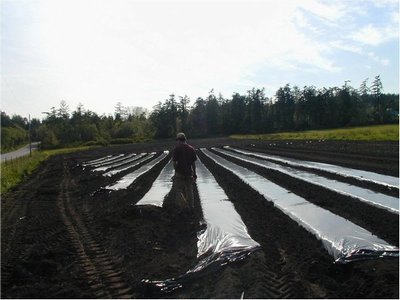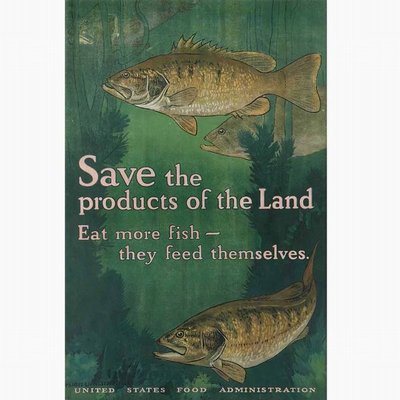November 4, 2010
Eat a fish, save a rainforest: Professor says to weigh alternatives before we curtail fishing

Without fishing, food will come from someplace else and at higher environmental costs, according to Ray Hilborn. This slide from his October lecture, for example, contrasts the species abundance and diversity of the forest at the edge of the field to farmland that has been cleared of plants and plowed. Photo / Ray Hilborn
Alarming news reports and journal articles in recent years about fisheries facing ruin the world over has led to calls to curtail, or more drastically, to completely cease harvesting fish from coastal and ocean waters.
But replacing fish harvested from the sea with equivalent amounts of animal protein from pigs, cattle and chickens could take land resources equivalent to 22 times the rainforest we currently have, according to calculations by Ray Hilborn, UW professor of aquatic and fishery sciences. If we just stop trawl fishing — often pointed to as the worst-of-the-worst ways to fish because nets drag along the bottom — it would still take five times more rainforest than we have, he estimates.
Hence the title Eat a Fish, Save a Rainforest for the lecture Hilborn delivered Oct. 26 as part of the series “Food: Eating Your Environment, organized by the UW Program on the Environment.

A poster from WWI was a concluding slide in Ray Hilborn’s lecture Eat a Fish, Save a Rainforest. Ray Hilborn
Hilborn says there are a limited number of fisheries such as Atlantic bluefin tuna where we know there are big problems and stocks are facing too much fishing pressure.
“Let’s concentrate on these problems and not condemn the whole of fishing,” he said. “Fish captured from marine waters make up a quarter to one-third of the animal protein consumed by humans globally — and in places is the only animal protein available. Replacing that food will come from some place and at much higher environmental costs.”
And before you vegetarians stop reading, Hilborn said to consider that areas fished for long-term sustainable yields may deplete fish abundance in an area by 70 percent and lower biodiversity by 30 percent but that should be considered in light of changes in species abundance and biodiversity when trees and other plants are removed and land plowed.
“What do you think,” he said showing a slide of freshly cleared and tilled land, “If that was previously a rainforest, is biodiversity lowered by only 30 percent?”
Key to Hilborn’ s argument that humans should keep fishing is that fish abundance in the world has overall been stable since the 1990s, most large fisheries are now sustainably managed and steps to curb overfishing appear to be succeeding in eight of 10 large marine ecosystems examined recently by an international group of fisheries experts. This bolsters the case that sound management can contribute to rebuilding of fisheries elsewhere, according to the group when they reported their findings in Science in 2009.
The group was led by Hilborn and former adversary Boris Worm of Dalhousie University, Nova Scotia. Back in 2006 Hilborn said it was mind-boggling stupid for Worm and his colleagues to say in Science that they’d detected a widespread global trend toward fisheries collapse that would lead to all fish harvested commercially being gone by 2048. The resulting news coverage frightened many people about the state of world fisheries.
The difference between the 2006 and 2009 Science papers is that the first relied on catch records, for lack of a better alternative, and the latter relied on actual estimates of abundance, as well as catch.
In his lecture, Hilborn’s notion of eat a fish, save a rainforest is based on a tally he’s trying to develop for fish, cattle, pigs and chickens. That tally
- Considers the resources used before one or the other ends up on the dinner table. Included could be such things as the fresh water needed and petroleum used in fertilizer to raise feed or grow pasture lands. On the fishing side would be such things as the petroleum needed to fuel vessels.
- Adds up the degradation such as manure in waterways and soil erosion from raising farm animals vs. garbage dumped at sea and oil or chemical spills from fishing.
- Totals the greenhouse gas emissions that result from both activities.
His numbers are preliminary because he said he’s just begun trying to get the data but a few examples of the annual costs of livestock range from the 487 million tons of soil eroded away by worldwide pork production to 12 million tons of fertilizer required for raising cattle to 5,000 tons of antibiotics to raise chickens.
These comparisons are needed so when people talk about greatly curtailing seafood harvesting they can consider that in light of what it might mean for land resources, Hilborn said.
Hilborn’s was the fourth of eight lectures in the “Food: Eating Your Environment” series where national and international experts are discussing food in its global setting including security, politics, science and society.
The lectures are free and open to the public, however, the response when seat reservations opened last summer was so strong that organizers scrambled to find larger venues and the only way to get a seat now is to show up near the start time when any open seats are up for grabs.
“Food is the ultimate environmental issue,” said Julia Parrish, professor of aquatic and fishery sciences and director of the Program on the Environment. “What we eat and where it comes from shape the world’s ecosystems more than any other human action. Seattle Defines the intersection of foodies and environmentalism, so it’s not surprising the response to the series is so positive.”
The series continues Tuesdays, from 6:30 to 8 p.m., through Nov. 30. It was organized by the Program on the Environment that has two academic offerings for UW students in conjunction with the series. Half the lectures are also part of the Jessie and John Danz and the Walker-Ames endowed lecture series. The food series is supported by the UW Alumni Association, College of the Environment and more than a dozen other groups on and off campus.
